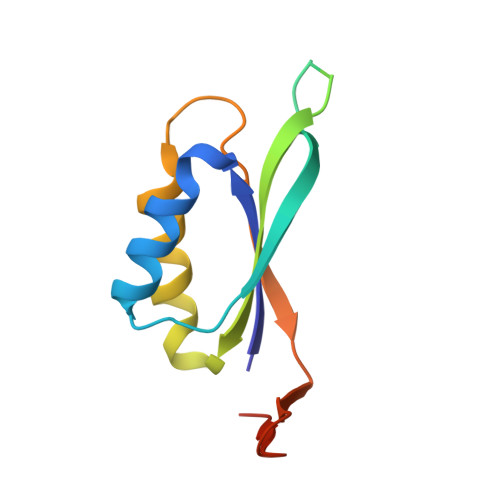Crystal structures of the signal transducing protein GlnK from Thermus thermophilus HB8.
Sakai, H., Wang, H., Takemoto-Hori, C., Kaminishi, T., Yamaguchi, H., Kamewari, Y., Terada, T., Kuramitsu, S., Shirouzu, M., Yokoyama, S.(2005) J Struct Biol 149: 99-110
- PubMed: 15629661
- DOI: https://doi.org/10.1016/j.jsb.2004.08.007
- Primary Citation of Related Structures:
1UFL, 1V3R, 1V3S, 1V9O, 1VFJ - PubMed Abstract:
The Thermus thermophilus HB8 genome encodes a signal transducing PII protein, GlnK. The crystal structures of GlnK have been determined in two different space groups, P2(1)2(1)2(1) and P3(1)21. The PII protein has the T-loop, which is essential for interactions with receptor proteins. In both crystal forms, three GlnK molecules form a trimer in the asymmetric unit. In one P2(1)2(1)2(1) crystal form, the three T-loops in the trimer are disordered, while in another P2(1)2(1)2(1) crystal form, the T-loop from one molecule in the trimer is ordered. In the P3(1)21 crystal, one T-loop is ordered while the other two T-loops are disordered. The conformations of the ordered T-loops significantly differ between the two crystal forms; one makes the alpha-helix in the middle of the T-loop, while the other has an extension of the beta-hairpin. Two different conformations are captured by the crystal contacts. The observation of multiple T-loop conformations suggests that the T-loop could potentially exhibit "polysterism," which would be important for interactions with receptor proteins. The crystal structures of the nucleotide-bound forms, GlnK.ATP and GlnK.ADP, have also been determined. ATP/ADP binding within a cleft at the interface of two adjacent T. thermophilus GlnK monomers might affect the conformation of the T-loop.
- Protein Research Group, RIKEN Genomic Sciences Center, 1-7-22 Suehiro-cho, Tsurumi, Yokohama 230-0045, Japan.
Organizational Affiliation:

















